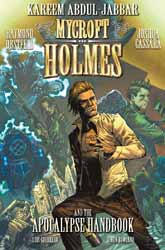|
Click here to return to the main site. Graphic Novel Review
An all-new epic graphic novel from author, activist, columnist and NBA All-Star athlete Kareem Abdul-Jabbar! Against his will, the idle but brilliant Mycroft Holmes is pulled into a globe-spanning adventure at the behest of Queen Victoria. A madman has stolen a handbook full of plans for civilisation-destroying weapons – and desires to sell them to the highest bidder. Can the smartest man in England track down and defeat the one foe that may prove to be his match? Co-written with Raymond Obstfeld and brought to life with stunning art by Joshua Cassara and Luis Guerrero, this swaggering Steampunk adventure will leave you in no doubt as to which of the Holmes brothers is your favourite…! This graphic novel collects the five-issue mini-series of the same name and is set in the world of the bestselling Mycroft Holmes novel, penned in 2015 by Kareem Abdul-Jabbar and Anna Waterhouse. This time the retired basketball legend’s co-author is novelist and screenwriter Raymond Obstfeld (The Joker and the Thief). The story takes place four years after the events of the novel, in 1874, though you would be forgiven for thinking that this is an earlier point in Mycroft’s life, as the indolent young man has reverted to the student life in preference to holding down a regular job. Long before he became a corpulent member of the Diogenes Club, Mycroft exhibits all the cocky attitude and cold logic that we have come to expect from his younger brother (especially as performed by Benedict Cumberbatch in BBC TV’s Sherlock). When posed the philosophical question of whether he would rescue the Mona Lisa or a pet dog from a burning building, Mycroft argues that he wouldn’t be inclined to save either of them: “A man could get injured. Worse, ruin a perfectly good suit. My tailor would be furious.” Unlike most depictions of Sherlock Holmes, however, Mycroft has a voracious sexual appetite. Sherlock himself makes a guest appearance, interrupting Mycroft in flagrante delicto with another man’s wife. The young Sherlock demonstrates that he already possesses a keen intellect, though he is rather perturbed by the sight of a beautiful naked woman – during which incident we see the formation of a familiar character trait… Despite their high levels of intelligence, Mycroft and Sherlock are not above name-calling – “Shitlick”, “Mycrotch” – and are typical brothers in that respect. However, there are also some revealing and touching flashbacks to the childhoods of both Holmes boys, showing a time when the now selfish and ruthless Mycroft possessed a surprising level of compassion. As you may have gathered by now, this comic is not for kids, containing as it does a fair amount of sex, gore and coarse language. The creative team set out their stall in the opening pages, during which a small boy admires a nude statue of the Roman goddess Venus (after which the nudity is mostly, though not entirely, implied) and a history teacher comes to an icky end, the first of several gruesome deaths. This scene, which takes place in the British Museum, also establishes the Steampunk aspect of the story, as the damage is done by a strange, apparently clockwork device. The genre of Steampunk owes an enormous debt to the imaginative writings of Jules Verne, one of the fathers of science fiction. His influence is acknowledged by the writers, as it is explained to Mycroft that the Apocalypse Handbook came about as a result of a convention of futurists arranged by Prime Minister Benjamin Disraeli. Real-life literary pioneers named during a brief flashback sequence also include Jean-Baptiste Cousin de Grainville (author of The Last Man), Jane C. Loudon (who penned The Mummy!: Or a Tale of the Twenty-Second Century), Samuel Butler (of Erewhon fame) and Mark Twain. There are also one or two homages to Mary Shelley’s Frankenstein. In case you’re wondering why H.G. Wells isn’t on the above list, this story takes place two decades before the publication of The Time Machine – though that doesn’t stop Edward Bellamy’s 1888 utopian novel Looking Backward from getting a mention. And if de Grainville was at any of those meetings, then one can only assume that he must have faked his own death, since by all accounts he committed suicide in 1805, just weeks after Disraeli was born! Balancing such quirks of chronology are some intriguing historical titbits, such as the fact that artificial respiration (as carried out by Mycroft himself) had been pioneered a century earlier by the English physician William Hawes), and a fascinating reference to Henry Fleuss (1851–1933), inventor of the first SCUBA (self-contained breathing apparatus) gear. All the action is impressively realised by artist Joshua Cassara (New Avengers), whose kinetic style captures moving objects such as cigar smoke, water droplets and furniture fragments in freeze-frame detail. And prepare to hold on to your stomach as Mycroft and his allies are forced to hide in an excrement-splattered outhouse! Following a relatively sedate penultimate chapter, Abdul-Jabbar and Obstfeld pack a lot of incident into their finale, almost as if they had expected their saga to continue for longer. As a result, Cassara is forced to cram in up to thirteen (but more often eight or nine) pictures per page. Some of the action during this final showdown flies past so quickly that it can occasionally be hard to make sense of it all. There’s no denying that this is a thrilling adventure, though, marred only by the aforementioned pacing problems and the occasional anachronism. For example, I was gobsmacked to read the word “gobsmacked” in the period dialogue. In other respects, though, this graphic novel will leave you gobsmacked in a good way! 9 Richard McGinlay Buy this item online
|
|---|


